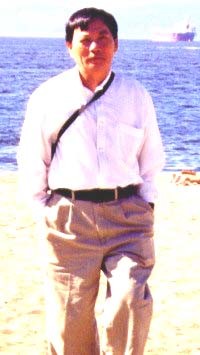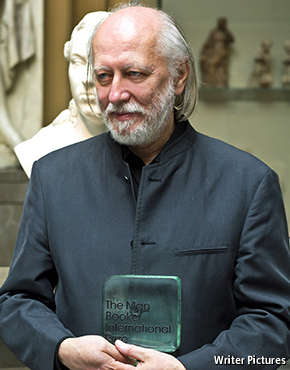 |
Man Booker
International prize 2015 Laszlo
Krasznahorkai’s modernist creations receive fitting recognition May 23rd
2015 | From the print edition BACK in 2007
Colm Toibin, a prizewinning Irish author, told a press conference that
the most
interesting writer he had come across in two years of reading
contemporary
fiction as a judge of that year’s Man Booker International prize was
Laszlo
Krasznahorkai, a reclusive Hungarian with a reputation for sentences so
long
and convoluted that some of them went on for an entire chapter. So impressed
was Mr Toibin by the Hungarian’s fabulist confections that he founded a
small
publishing imprint, Tuskar Rock Press, to bring just such fiction to a
wider
audience. Eight years on, Mr Toibin’s faith in Mr Krasznahorkai’s
talent has
been vindicated. Just after Tuskar brought out his latest book, “Seiobo
There Below”,
in Britain, the Hungarian novelist was named the winner of the Man
Booker
International prize for 2015 on May 19th. Now ten years old, the award
differs
from the annual Man Booker prize for fiction in that it is presented
every two
years, and for a body of work rather than a single book. This novel
of 17 stories brings together a series of artists—for example, the
Italian
Renaissance painter Perugino in his workshop, a Japanese Noh actor
rehearsing—and ordinary people who are trying to grasp what sacred
means or to
understand what beauty, art and transcendence might look like. Mr
Krasznahorkai’s writing worries at these eternal questions, picking and
unpicking tiny details, actions and reactions, in a relentless attempt
both to
pin down and to describe the complexities of contemporary life. The Hungarian is not the first modernist to manhandle prose and use the sentence as instrument. But even more than, say, Thomas Bernhard or W.G. Sebald, he winds and unwinds and rewinds, creating what one translator described as “a slow lava-flow of narrative, a vast black river of type”, which along the way acquires a transcendent quality of its own. The stories in “Seiobo There Below” are arranged according to the Fibonacci mathematical sequence, with each one as long as the two previous ones combined, which adds to the reader’s sense of being on a journey. As always with Mr Krasznahorkai, real understanding remains beyond grasp, though a sense of illumination is pervasive. As a novelist he is a one-off, even if his work—as this book so finely shows—is universal. Note: Trên The New Yorker
cũng có 1 bài về tay này. Bài của Người Kinh Tế thường là ngắn
gọn, dễ chôm/giới thiệu hơn. Man Booker
International prize 2015 won by 'visionary' László Krasznahorkai ‘Difficult in the same way Beckett is difficult’ ... László Krasznahorkai. Photograph: Murdo Macleod His first and most famous novel. It tells the story of life in a disintegrating village in a dystopian communist Hungary, where a man called Irimias, long thought dead and who may be a prophet, a secret agent or the devil, appears out of nowhere and begins to manipulate the remaining citizens. According to the Guardian review, this is “a monster of a novel: compact, cleverly constructed, often exhilarating, and possessed of a distinctive, compelling vision – but a monster nevertheless. It is brutal, relentless and so amazingly bleak that it’s often quite funny.” It won the 2013 best translated book award in the fiction category. The
Hungarian author László Krasznahorkai, whose sentences roll out over
paragraphs in what his translator George Szirtes has called a “slow
lava flow of narrative, a vast black river of type”, has won the Man Booker International prize for his
“achievement in fiction on the world stage”. Giải thưởng Man Booker Intel năm nay 2015 về tay nhà văn Hung, câu văn dài, thường tràn ra khỏi lề sách, và như 1 dòng sông đen bao la, 1 dòng nham thạch của tự sự, rất khó đọc, khó cái kiểu của Beckett, và, như tác giả thú nhận, Thầy của tôi là Kafka. Warner called Krasznahorkai’s prose “absolutely stunning”, and a “thrilling” experience to read. “This extraordinary style he has, which people sometimes object to – if you think of it like music, the piece begins, and at first you don’t know where you are, it’s unfamiliar, and then it begins to feel natural, the rhythm keeps puling you along,” she said. “He’s difficult in the same way Beckett is difficult, or Dante is difficult. Kafka also has that quality.” Satantango’s epigraph is taken from Kafka – “In that case, I’ll miss the thing by waiting” – and the author told the Guardian earlier this month that he has “only one” literary hero: “K, in the works of Kafka. I follow him always.” He told The White Review, in an interview with Szirtes: “When I am not reading Kafka I am thinking about Kafka. When I am not thinking about Kafka I miss thinking about him. Having missed thinking about him for a while, I take him out and read him again.” Tuy nhiên, do THNM, đọc cái tóm tắt cuốn đầu tay
của ông, thì GCC bèn nghĩ
ngay tới… Bác Hồ: Đây là câu chuyện 1 xứ sở tan hoang rã rời, mê trùn[g] đỏ, nơi có 1 vị có tên là Bác Hồ, dân chúng tưởng đã ngỏm từ đời nào, và có thể còn là 1 nhà tiên tri, một mật vụ của Xì, hay 1 con quỉ, không biết từ xó xỉnh nào, bỗng xuất hiện, và bắt đầu thao túng dân chúng còn lại... |
